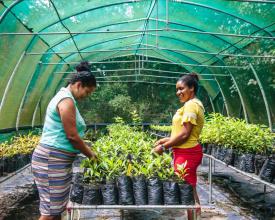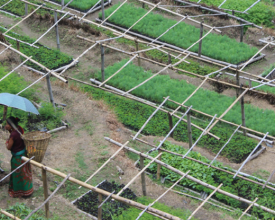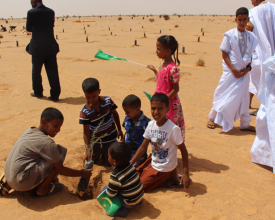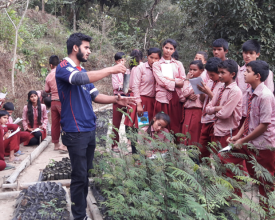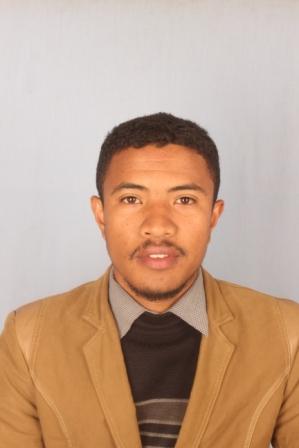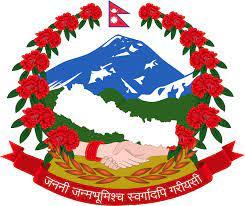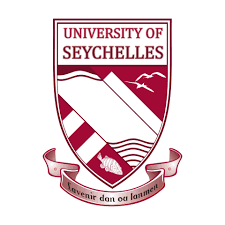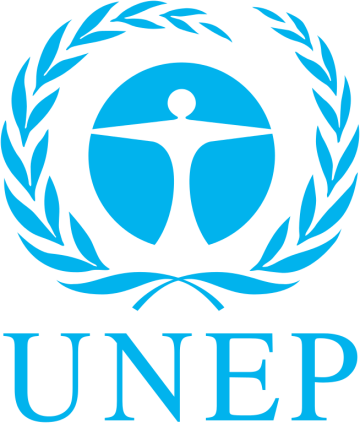
Renforcer les capacités, les connaissances et le soutien technologique pour renforcer la résilience climatique des pays en développement vulnérables grâce à la coopération Sud-Sud (EbA South)
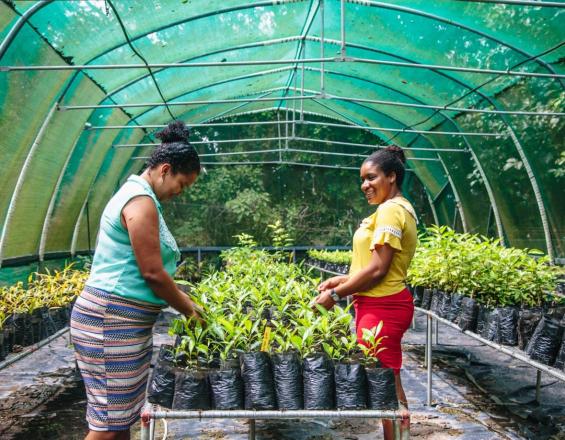
Le changement climatique a un impact considérable sur les communautés locales d'Asie-Pacifique et d'Afrique, qui dépendent fortement des écosystèmes pour leur subsistance. Dans le cadre de ce projet financé par le FEM et intitulé EbA South, le PNUE et quatre gouvernements se sont penchés sur la promotion de l'EbA par le biais de la coopération sud-sud.
L'objectif était d'améliorer la résilience climatique des communautés en Mauritanie, au Népal et aux Seychelles en renforçant les capacités institutionnelles, en mobilisant les connaissances et en transférant les technologies EbA sur la base de l'expérience de la Chine dans la mise en œuvre réussie de la restauration.
Ce projet est reconnu comme une initiative phare de la coopération Sud-Sud, permettant un échange de transfert de technologie, de renforcement des capacités, de soutien politique ou de collecte de fonds entre les pays du Sud. Le projet a démontré diverses bonnes pratiques et a produit un large éventail d'outils et de produits de connaissance afin d'encourager le NbS pour l'adaptation par le biais de la coopération Sud-Sud.
Contexte
Défis à relever
Le changement climatique a des répercussions importantes dans ces régions. Les températures augmentent et la fréquence et l'intensité des catastrophes liées au climat, telles que les inondations, les glissements de terrain, les incendies et les sécheresses, s'accroissent, et les communautés locales ont une capacité limitée à faire face à ces effets.
Les informations et les capacités techniques disponibles pour une mise en œuvre efficace de l'EbA sont limitées. En effet, i) les informations sur l'efficacité à long terme des interventions d'adaptation ne sont pas rassemblées, synthétisées et diffusées ; ii) les interventions d'EbA ne sont pas mises en œuvre dans un cadre scientifique rigoureux de recherche à long terme ; iii) les cadres politiques et juridiques n'encouragent pas l'EbA, et iv) la formation est insuffisante.
Les échanges sur l'EbA à l'échelle régionale et transnationale sont donc essentiels. Cependant, ces échanges peuvent être fortement limités par la barrière de la langue. L'anglais a été le vecteur de la collaboration, bien qu'il s'agisse de la deuxième ou de la troisième langue de la plupart des participants.
Emplacement
Traiter
Résumé du processus
Le premier élément est la première étape de l'élaboration d'un projet de coopération sud-sud. Il est essentiel d'identifier quelles connaissances doivent être partagées et comment. Les pays peuvent utiliser une plateforme existante ou en créer une nouvelle. Les ateliers de partage des connaissances peuvent également faciliter la collaboration entre les pays et faciliter la diffusion des connaissances auprès de parties prenantes spécifiques. Si l'utilisation d'une langue commune n'est pas possible, le recours à des interprètes sera nécessaire. Des visites de terrain et des ateliers peuvent également être organisés pour faciliter ce processus.
Ensuite, dans le cadre du deuxième bloc de construction, un transfert de technologie concret peut être réalisé grâce au renforcement des capacités interrégionales, les experts et les coordinateurs de projet se rencontrant régulièrement dans le cadre d'ateliers, de formations, de visites sur le terrain et de conférences. Ce transfert de technologie peut également être réalisé en créant des cadres concrets, tels que le LTRP, qui a permis de mesurer les effets des interventions d'EbA et de les partager avec d'autres pays.
Blocs de construction
Échange de connaissances et d'expériences entre pays
Les moyens de communication et les plateformes peuvent être utilisés pour échanger les expériences de l'EbA entre les différents pays et au-delà des différentes activités. Dans le cadre du projet EbA South, des ateliers de partage des connaissances ont été organisés en Asie-Pacifique, en Afrique et en Amérique latine. Par exemple, l'atelier d'échange Sud-Sud "Ecosystems for Climate Change Adaptation" a été organisé en Asie-Pacifique, en Afrique et en Amérique latine : Ecosystems for Climate Change Adaptation and Sustainable Livelihoods Knowledge Sharing" (Atelier d'échange Sud-Sud : partage des connaissances sur les écosystèmes pour l'adaptation au changement climatique et les moyens de subsistance durables) s'est tenu à Beijing, en Chine. Cet échange de connaissances Sud-Sud a débouché sur une série de publications et d'outils désormais utilisés par les praticiens de l'ensemble des pays du Sud pour encourager les solutions d'adaptation fondées sur la nature par le biais de la coopération Sud-Sud. Une plateforme web a également été créée pour faciliter la collaboration - elle contient des webinaires, des études de cas, un outil de planification de l'adaptation fondée sur les écosystèmes et d'autres produits de connaissance. Des programmes de recherche peuvent également être mis en place en partenariat avec des universités locales afin de poursuivre le partage et l'application de ces connaissances.
Ces ateliers et ces produits de connaissance ont fourni de bonnes occasions de partager et d'échanger diverses expériences du projet avec des scientifiques et des praticiens de la communauté EbA au sens large. La coopération Sud-Sud permet un échange EbA efficace entre les pays en développement qui ont des défis et des solutions communs en matière de conservation et de moyens de subsistance.
Facteurs favorables
- La création d'une plateforme d'échange de connaissances en ligne peut contribuer à la diffusion de toutes ces connaissances et données et faciliter les discussions entre les pays. Si possible, cette plateforme devrait être disponible dans toutes les langues pertinentes pour les pays qui y participent.
- L'organisation d'ateliers, de visites sur le terrain, de webinaires peut contribuer à l'échange de connaissances entre les pays.
- La barrière de la langue peut être un problème ; il peut donc être utile de faire appel à des interprètes ou de faire traduire les outils et les plates-formes.
Leçon apprise
Lors de l'échange d'expériences, de connaissances, de données, de résultats et d'idées au cours d'ateliers, de visites sur le terrain et de webinaires entre différents pays, ou par le biais de plateformes et d'outils en ligne, la communication peut s'avérer problématique en raison de la barrière linguistique. Au cours de ce projet, l'anglais a été le moyen de collaboration, bien qu'il s'agisse de la deuxième ou troisième langue de la plupart des participants. La barrière linguistique a également limité la collaboration après les ateliers.
Le flux de connaissances et d'apprentissage peut être amélioré en engageant des interprètes professionnels pendant les expéditions et les ateliers. L'engagement d'interprètes professionnels ayant des connaissances scientifiques pendant les expéditions et les ateliers aurait permis d'accroître les avantages de la collaboration.
Transfert de technologies et renforcement des capacités entre pays
La capacité institutionnelle à soutenir le transfert de technologie EbA a été renforcée par la formation et par le développement et la mise en œuvre conjoints du programme de recherche à long terme (LTRP) en partenariat avec les universités locales, afin de mesurer les effets à court et à long terme des interventions EbA. Les activités comprenaient l'établissement de sites de surveillance, la conduite d'activités de recherche, la collecte de données et la publication des résultats sous forme de rapports techniques, de documents de recherche, de thèses de licence, de thèses de master, de thèses de doctorat et d'articles évalués par des pairs.
Au Népal, par exemple, le développement des interventions d'EbA a commencé par l'évaluation des pratiques locales et la détermination de la possibilité d'améliorer ou d'étendre ces pratiques avant d'introduire de nouvelles approches. Sur la base de ces résultats, les experts chinois et sud-africains ont conçu des interventions possibles en collaboration avec l'expert local et ont donné des conseils sur leur mise en œuvre et leur suivi par rapport aux indicateurs et aux objectifs du projet.
Le transfert de technologie s'est également effectué par le biais d'un renforcement des capacités interrégionales, les experts de l'EbA et les coordinateurs de projet se rencontrant régulièrement dans le cadre du comité directeur, d'ateliers, de formations, de visites de sites et de conférences.
Facteurs favorables
- Le LTRP doit être fondé sur des pratiques rigoureuses pour aider à former la base d'une prise de décision appropriée et efficace en matière d'adaptation.
- La volonté des institutions académiques de s'impliquer dans des projets de recherche pratiques qui amélioreront les preuves de la mise à l'échelle de l'EbA.
- La création d'une plateforme, si possible disponible dans toutes les langues concernées, peut contribuer à diffuser toutes ces connaissances et à faciliter les discussions entre les pays.
- La barrière de la langue peut être un problème, c'est pourquoi il peut être utile de faire appel à des interprètes ou de faire traduire les outils et les plateformes.
Leçon apprise
Le renforcement précoce des capacités dans les pays permet de partager des données scientifiques fiables et les enseignements tirés de l'expérience. De nombreuses variables environnementales, économiques et sociales entrent en jeu pour que l'EbA soit durable, et il est important de documenter les bonnes pratiques, ainsi que les leçons et les défis des sites pilotes.
La conception du projet a permis aux trois pays d'utiliser un programme de recherche à long terme (LTRP) en partenariat avec les universités locales. Ensemble, ils ont mesuré et rapporté les effets à court et à long terme (écologiques, hydrologiques et socio-économiques) des interventions EbA. Grâce à ce solide volet de collecte de données et de recherche, le projet a permis de tirer des enseignements qui peuvent servir de base à l'extension de l'EbA.
Le transfert de technologie et les activités de renforcement des capacités peuvent être facilités par l'embauche d'interprètes professionnels lors des expéditions, des visites et des ateliers, afin de surmonter les barrières linguistiques et d'accroître les avantages de la collaboration entre les pays.
Impacts
- Promotion réussie de la coopération Sud-Sud sur l'EbA, principalement par l'échange de connaissances et d'expériences de la Chine vers les pays pilotes et au-delà, ainsi que par l'apprentissage de pair à pair entre les pays pilotes. Cela a permis de créer une communauté de pratique pour la reproduction et l'extension de l'approche de l'EbA.
- De nombreux produits de connaissance ont été élaborés, tels que des outils de planification de l'EbA, un manuel, un programme d'enseignement, des études de cas sur les bonnes pratiques et les enseignements tirés du projet.
- Une plateforme a été créée pour partager les approches et les résultats du projet, les leçons, les boîtes à outils et les meilleures pratiques.
- Des programmes de recherche ont été mis en place en partenariat avec des universités locales afin de faire progresser la science de l'eba et de mesurer les effets des activités de restauration du projet. Treize articles scientifiques ont été produits par l'équipe du Népal, sept par celle des Seychelles et onze par celle de la Mauritanie.
- Le Forum de haut niveau sur la coopération Sud-Sud en matière de changement climatique a été lancé par le projet afin de renforcer les partenariats mondiaux par le biais de la coopération entre les partenaires du Sud.
Bénéficiaires
Les communautés vivant dans les zones côtières des Seychelles (îles Mahé, Praslin et Curieuse), dans les zones arides de Mauritanie (provinces de l'Inchiri et du Trarza) et dans les forêts montagneuses du Népal (Chiti, Jita) étaient les bénéficiaires du projet.
Objectifs de développement durable
Histoire
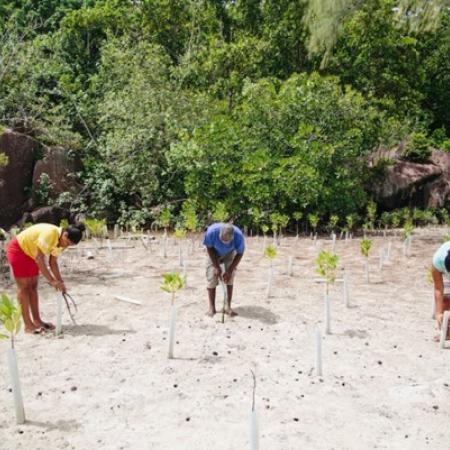
Les Seychelles, nation connue pour ses plages exquises et ses eaux turquoise, ont été décrites par certains comme un paradis en train de sombrer : "Aujourd'hui, on peut voir l'eau monter. C'est le changement climatique", explique Godfrey Albert, 48 ans, un pêcheur seychellois de l'île de Mahé. "À cette époque de l'année, nous ne sommes pas censés avoir de la pluie et pourtant nous en avons. Au-delà des précipitations irrégulières, la multiplication des tempêtes côtières et l'élévation du niveau de la mer érodent les côtes et inondent les terres. Pour un pays où 80 % des activités économiques se déroulent dans les régions côtières, il s'agit d'une grave menace.
Faisant un geste vers le large, Albert hausse les épaules : "Je te l'ai dit, mec. La vie est dure au paradis".
Ces effets climatiques sont encore aggravés par la destruction des forêts côtières de mangroves qui entouraient autrefois la plupart des 115 îles du pays. Les mangroves constituent une défense extrêmement efficace contre les inondations et l'érosion côtières en réduisant la hauteur et la force des vagues.
Le sort de l'industrie de la pêche, qui est, avec le tourisme, la principale source de revenus du pays, est lié aux mangroves. Les forêts constituent un lieu de reproduction pour les poissons avant qu'ils ne partent en mer, et la matière organique piégée dans les racines offre des nutriments vitaux pour de nombreuses espèces de poissons.
Financé par le Fonds pour l'environnement mondial, un projet a travaillé avec des communautés des Seychelles, de Mauritanie et du Népal, afin d'utiliser la nature pour s'adapter aux effets du changement climatique, une stratégie appelée "adaptation fondée sur les écosystèmes" (EbA).
Le projet, connu sous le nom d'EbA South, a été mis en œuvre par la Commission nationale pour le développement et la réforme de la Chine, par l'intermédiaire de l'Académie chinoise des sciences. En plantant des mangroves à travers les Seychelles, EbA South a démontré comment les pays peuvent renforcer la résilience des communautés locales face aux tempêtes et aux inondations tout en améliorant les stocks de poissons locaux.
Les forêts de mangroves restaurées protègent non seulement la terre de la mer, mais aussi la mer de la terre en filtrant les détritus et les sédiments qui descendent des montagnes et se déversent dans les océans. Sans les mangroves, les sédiments recouvrent le corail, tuant les poissons et les entreprises de pêche locales.
"Les mangroves jouent un rôle important dans la mer. Elles filtrent tout", explique Missia Dubignon, bénévole de la Terrestrial Restoration Action Society of the Seychelles (TRASS) Trust, partenaire d'EbA South.
"Planter un arbre, c'est sauver une vie", dit Dubignon en souriant.

